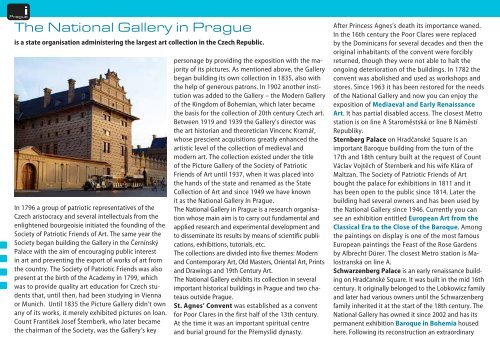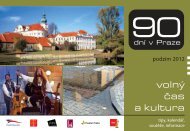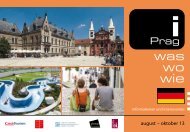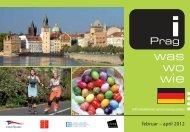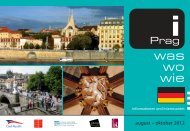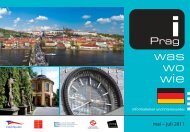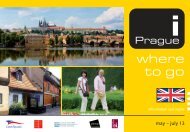where to go - i-Prague
where to go - i-Prague
where to go - i-Prague
Create successful ePaper yourself
Turn your PDF publications into a flip-book with our unique Google optimized e-Paper software.
i<br />
<strong>Prague</strong><br />
The National Gallery in <strong>Prague</strong><br />
is a state organisation administering the largest art collection in the Czech Republic.<br />
In 1796 a group of patriotic representatives of the<br />
Czech aris<strong>to</strong>cracy and several intellectuals from the<br />
enlightened bourgeoisie initiated the founding of the<br />
Society of Patriotic Friends of Art. The same year the<br />
Society began building the Gallery in the Černínský<br />
Palace with the aim of encouraging public interest<br />
in art and preventing the export of works of art from<br />
the country. The Society of Patriotic Friends was also<br />
present at the birth of the Academy in 1799, which<br />
was <strong>to</strong> provide quality art education for Czech students<br />
that, until then, had been studying in Vienna<br />
or Munich. Until 1835 the Picture Gallery didn’t own<br />
any of its works, it merely exhibited pictures on loan.<br />
Count František Josef Šternberk, who later became<br />
the chairman of the Society, was the Gallery’s key<br />
personage by providing the exposition with the majority<br />
of its pictures. As mentioned above, the Gallery<br />
began building its own collection in 1835, also with<br />
the help of generous patrons. In 1902 another institution<br />
was added <strong>to</strong> the Gallery – the Modern Gallery<br />
of the Kingdom of Bohemian, which later became<br />
the basis for the collection of 20th century Czech art.<br />
Between 1919 and 1939 the Gallery’s direc<strong>to</strong>r was<br />
the art his<strong>to</strong>rian and theoretician Vincenc Kramář,<br />
whose prescient acquisitions greatly enhanced the<br />
artistic level of the collection of medieval and<br />
modern art. The collection existed under the title<br />
of the Picture Gallery of the Society of Patriotic<br />
Friends of Art until 1937, when it was placed in<strong>to</strong><br />
the hands of the state and renamed as the State<br />
Collection of Art and since 1949 we have known<br />
it as the National Gallery In <strong>Prague</strong>.<br />
The National Gallery in <strong>Prague</strong> is a research organisation<br />
whose main aim is <strong>to</strong> carry out fundamental and<br />
applied research and experimental development and<br />
<strong>to</strong> disseminate its results by means of scientific publications,<br />
exhibitions, tu<strong>to</strong>rials, etc.<br />
The collections are divided in<strong>to</strong> five themes: Modern<br />
and Contemporary Art, Old Masters, Oriental Art, Prints<br />
and Drawings and 19th Century Art.<br />
The National Gallery exhibits its collection in several<br />
important his<strong>to</strong>rical buildings in <strong>Prague</strong> and two chateaus<br />
outside <strong>Prague</strong>.<br />
St. Agnes’ Convent was established as a convent<br />
for Poor Clares in the first half of the 13th century.<br />
At the time it was an important spiritual centre<br />
and burial ground for the Přemyslid dynasty.<br />
After Princess Agnes’s death its importance waned.<br />
In the 16th century the Poor Clares were replaced<br />
by the Dominicans for several decades and then the<br />
original inhabitants of the convent were forcibly<br />
returned, though they were not able <strong>to</strong> halt the<br />
on<strong>go</strong>ing deterioration of the buildings. In 1782 the<br />
convent was abolished and used as workshops and<br />
s<strong>to</strong>res. Since 1963 it has been res<strong>to</strong>red for the needs<br />
of the National Gallery and now you can enjoy the<br />
exposition of Mediaeval and Early Renaissance<br />
Art. It has partial disabled access. The closest Metro<br />
station is on line A Staroměstská or line B Náměstí<br />
Republiky.<br />
Sternberg Palace on Hradčanské Square is an<br />
important Baroque building from the turn of the<br />
17th and 18th century built at the request of Count<br />
Václav Vojtěch of Šternberk and his wife Klára of<br />
Maltzan. The Society of Patriotic Friends of Art<br />
bought the palace for exhibitions in 1811 and it<br />
has been open <strong>to</strong> the public since 1814. Later the<br />
building had several owners and has been used by<br />
the National Gallery since 1946. Currently you can<br />
see an exhibition entitled European Art from the<br />
Classical Era <strong>to</strong> the Close of the Baroque. Among<br />
the paintings on display is one of the most famous<br />
European paintings the Feast of the Rose Gardens<br />
by Albrecht Dürer. The closest Metro station is Malostranská<br />
on line A.<br />
Schwarzenberg Palace is an early renaissance building<br />
on Hradčanské Square. It was built in the mid 16th<br />
century. It originally belonged <strong>to</strong> the Lobkowicz family<br />
and later had various owners until the Schwarzenberg<br />
family inherited it at the start of the 18th century. The<br />
National Gallery has owned it since 2002 and has its<br />
permanent exhibition Baroque in Bohemia housed<br />
here. Following its reconstruction an extraordinary


